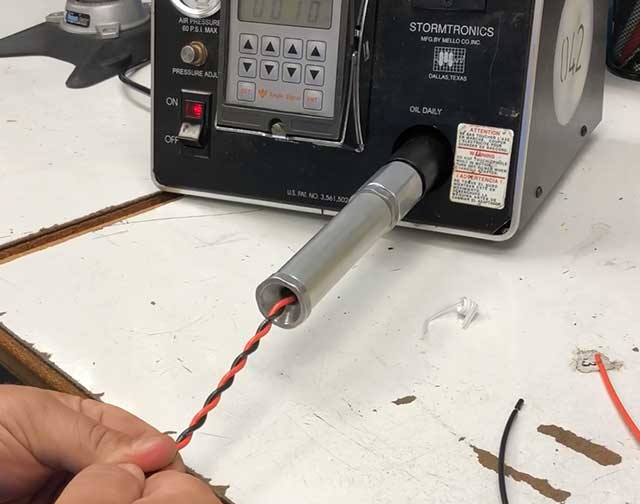Hook Up Wire Twisting
Order Pre-Cut, Stripped and Tin Dipped Hook Up Wire Online
We offer many types of hook up wire with the option of twisting. Wires can be twisted together to block or limit EMI (Electromagnetic Interference) while signals are transmitted back and forth. A more simple reason to twist wires together is to make the wires look neat when they are installed rather than having multiple wires hanging loosely in an application.
The Twisting Process
Customers can use our website to purchase hook up wire and have it twisted together for an additional charge. Once two wires are chosen (same length) there will be an optional service listed that allows the two wires to be twisted. Up to 4 wires can twist together and the shopping cart will clearly show the product and services pricing separately. It takes more than 100’ of each wire to have a completed spool of 100’, but that’s incorporated into the pricing. We don’t expect the customer to figure out the calculation.
Once the order comes through we need to enter it and have it prepared. First, we retrieve the colors with an extra 10% and put them in line for the twisting machine. The machine can be set for loose or tight twists, known as the “twists per inch” setting. The wires are fed through the machine, twisted and wound onto another spool at the other end. Because we offer so many color options, we do not keep twisted spools in stock and instead make each spool to order.
Twisting and Striping Hook up Wire
Wire harnesses can sometimes have many more than 10 wires connected to the same assembly and require more than 10 colors to distinguish the pin placement on each side. WesBell can add a spiral stripe to each wire before sending it through the twisting process and it’s easy to order through our website. Once the customer chooses both spools of wire they can add a spiral stripe to each and choose to twist them together. It will clearly show the finished product and separate the pricing of products and services.
Short Length Wire Harness Twisting
Wire harness assemblies sometimes require the copper wires to be twisted as well, however, it’s not beneficial to have a full spool of 100’ in order to make 6” pieces. It’s more efficient to first cut the wire into 6” pieces on a wire cutting machine because it will also strip the insulation off each end as it’s being cut. In fact, we usually hand crimp terminals to the end before twisting them together as well. Once the wires are cut and the insulation is stripped, WesBell has a wire twisting machine that allows you to insert two wires, clamp the end and twist them together. The process is similar to putting two wires into the end of a power drill and pushing the trigger, except this machine is operated with a foot pedal.
Once the wire has been cut, stripped, crimped, twisted and inserted into the housing the harness can be plugged into its application. The metal from the terminal is connected to the copper and transmits electricity once it’s plugged in. Many times there will also be heat shrink tubing or sleeving used over the twisted wire for either looks or protection. When the electrical current stops transmitting it can be difficult to find the malfunctioning wire and expensive to fix, so protection risk assessment is a worthwhile task to complete before leaving wires exposed to possible harm during an application
Twisted Pair Electronic Cables
Electronic cables have an outer jacket that surrounds multiple wires for cleanliness and added protection. The inner wires can be twisted before being covered in order to block EMI from any nearby cables in the same application. Twisted pair cables can get complicated because they sometimes have 50 pairs that are each individually twisted and individually shielded. In order for assemblers to work on the cables there can be numerous levels of protection to get through before getting to the copper itself. First, they would remove the outer jacket, then remove each foil shield, then remove the insulation from each conductor and finally crimp a terminal to the copper. Again, heat shrink tubing is commonly used for cleanliness to cover the 2 inches before and after the rip of the outer jacket. The image above shows how the tubing is heated down and how it adheres to the cable for a clean look.
The Cost to Twist Hook Up Wire
The costs incurred from twisting wires starts with the twisting machine investment. The machine is costly but lasts for many years and proves to be an investment over time. The wires enter through one side, twist together on the inside and come out the other end. Then there’s the product cost of the two wires and the overage needed to create the twist. Finally, the cost of labor to get the wire, set up the machine, quality check the twist and package it for shipping. There was also an initial charge to have the programming set up on our website that allows customers to order twisted wires as they checkout. Small quantities of twisted wire (close to 100 feet) can seem much more costly due to the labor charges of the entire process, however the prices lower dramatically over 500 to 1000 feet.
Ultimately, the reasoning behind twisted wires is the same: cleanliness and blocking EMI. You can use the notes section of our website to specify how many twists per inch you need for your application and we’ll accommodate, otherwise, we’ll create the standard 2-3 twists per inch. Please notify us if you have any questions or comments about our twisting process or if you need a custom job completed. We’d love to hear from you!

